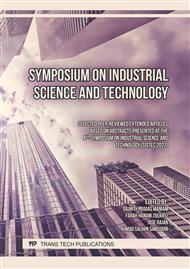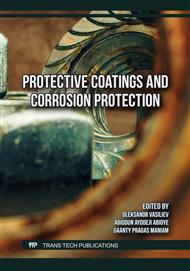[1]
R. Pelrine, R. Kornbluh, Q. Pei, and J. Joseph, "High-speed electrically actuated elastomers with strain greater than 100%," Science (1979), vol. 287, no.5454, 2000.
DOI: 10.1126/science.287.5454.836
Google Scholar
[2]
N. Ni and L. Zhang, "Dielectric Elastomer Sensors," in Elastomers, 2017.
DOI: 10.5772/intechopen.68995
Google Scholar
[3]
F. B. Madsen, L. Yu, A. E. Daugaard, S. Hvilsted, and A. L. Skov, "Silicone elastomers with high dielectric permittivity and high dielectric breakdown strength based on dipolar copolymers," Polymer (Guildf), vol. 55, no. 24, p.6212–6219, Nov. 2014.
DOI: 10.1016/j.polymer.2014.09.056
Google Scholar
[4]
F. Galantini, S. Bianchi, V. Castelvetro, and G. Gallone, "Functionalized carbon nanotubes as a filler for dielectric elastomer composites with improved actuation performance," Smart Mater Struct, vol. 22, no. 5, p.055025, May 2013.
DOI: 10.1088/0964-1726/22/5/055025
Google Scholar
[5]
Y. Wang, S. Kim, G. P. Li, and L. Z. Sun, "Filler orientation effect on relative permittivity of dielectric elastomer nanocomposites filled with carbon nanotubes," Comput Mater Sci, vol. 104, p.69–75, Jun. 2015.
DOI: 10.1016/J.COMMATSCI.2015.03.022
Google Scholar
[6]
P. S. Mazurek, L. ; Yu, R. ; Gerhard, W. ; Wirges, and A. L. Skov, "Glycerol as high- permittivity liquid filler in dielectric silicone elastomers," J Appl Polym Sci, vol. 133, no. 43, 2016.
DOI: 10.1002/app.44153
Google Scholar
[7]
L. Yu and A. L. Skov, "ZnO as a cheap and effective filler for high breakdown strength elastomers," RSC Adv, vol. 7, no. 72, p.45784–45791, 2017.
DOI: 10.1039/c7ra09479e
Google Scholar
[8]
V. Cârlescu, G. PrisǍcaru, and D. Olaru, "Electromechanical response of silicone dielectric elastomers," in IOP Conference Series: Materials Science and Engineering, Sep. 2016, vol. 147, no.1.
DOI: 10.1088/1757-899X/147/1/012057
Google Scholar
[9]
P. Mazurek, L. Yu, R. Gerhard, W. Wirges, and A. L. Skov, "Glycerol as high-permittivity liquid filler in dielectric silicone elastomers," J Appl Polym Sci, vol. 133, no. 43, Nov. 2016.
DOI: 10.1002/app.44153
Google Scholar
[10]
D. Onggo, O. K. Putri, and M. Aminah, "Utilization of nata de coco as a matrix for preparation of thin film containing spin crossover iron (II) complexes," IOP Conf Ser Mater Sci Eng, vol. 79, p.012021, Jun. 2015.
DOI: 10.1088/1757-899X/79/1/012021
Google Scholar
[11]
K. Potivara and M. Phisalaphong, "Development and characterization of bacterial cellulose reinforced with natural rubber," Materials, vol. 12, no. 14, 2019.
DOI: 10.3390/ma12142323
Google Scholar
[12]
M. Matsumoto, M. Yamamoto, and K. Kondo, "Use of Bacterial Cellulose from Nata de Coco as Base Polymer for Liquid Membranes Containing Ionic Liquids," Aust J Chem, vol. 65, no. 11, p.1497, 2012.
DOI: 10.1071/CH12307
Google Scholar
[13]
D. Ciecholewska-Juśko et al., "Superabsorbent crosslinked bacterial cellulose biomaterials for chronic wound dressings," Carbohydr Polym, vol. 253, p.117247, Feb. 2021.
DOI: 10.1016/j.carbpol.2020.117247
Google Scholar
[14]
M. T. Luo et al., "Cellulose-based absorbent production from bacterial cellulose and acrylic acid: Synthesis and performance," Polymers (Basel), vol.10, no. 7, p.702, Jun. 2018.
DOI: 10.3390/polym10070702
Google Scholar
[15]
M. Razzaghi Kashani, S. Javadi, and N. Gharavi, "Dielectric properties of silicone rubber- titanium dioxide composites prepared by dielectrophoretic assembly of filler particles," Smart Mater Struct, vol. 19, no. 3, 2010.
DOI: 10.1088/0964-1726/19/3/035019
Google Scholar
[16]
M. Razzaghi-Kashani, N. Gharavi, and S. Javadi, "The effect of organo-clay on the dielectric properties of silicone rubber," Smart Mater Struct, vol. 17, no. 6, p.065035, Dec. 2008.
DOI: 10.1088/0964-1726/17/6/065035
Google Scholar
[17]
M. Adrees et al., "Characterization of novel polydimethylsiloxane (PDMS) and copolymer polyvinyl chloride-co-vinyl acetate (PVCA) enhanced polymer blend membranes for CO2 separation," Polym Test, vol. 80, p.106163, Dec. 2019.
DOI: 10.1016/j.polymertesting.2019.106163
Google Scholar
[18]
H. NADIA, C. I. MOHD, A. MOHD, and A. ISHAK, "Physicochemical Properties and Characterization of Nata de Coco from Local Food Industries as a Source of Cellulose," Sains Malays, vol. 41, no. 2, p.205–211, Feb. 2012.
Google Scholar
[19]
A. B. Beltran, G. M. Nisola, E. Cho, E. E. D. Lee, and W. J. Chung, "Organosilane modified silica/polydimethylsiloxane mixed matrix membranes for enhanced propylene/nitrogen separation," Appl Surf Sci, vol. 258, no. 1, p.337–345, Oct. 2011.
DOI: 10.1016/j.apsusc.2011.08.061
Google Scholar
[20]
J. Wang, Y. Li, Z. Zhang, and Z. Hao, "Mesoporous KIT-6 silica-polydimethylsiloxane (PDMS) mixed matrix membranes for gas separation," J Mater Chem A Mater, vol. 3, no. 16, p.8650–8658, Apr. 2015.
DOI: 10.1039/c4ta07127a
Google Scholar
[21]
T. Xu et al., "Sulfonated titania submicrospheres-doped sulfonated poly(ether ether ketone) hybrid membranes with enhanced proton conductivity and reduced methanol permeability," J Power Sources, vol. 196, no. 11, p.4934–4942, Jun. 2011, doi:10.1016/j.jpowsour. 2011.02.017.
DOI: 10.1016/j.jpowsour.2011.02.017
Google Scholar
[22]
B. Alonso and C. Sanchez, "Structural investigation of polydimethylsiloxane-vanadate hybrid materials," J Mater Chem, vol. 10, no. 2, p.377–386, Jan. 2000.
DOI: 10.1039/a908032e
Google Scholar
[23]
D. Cai, A. Neyer, R. Kuckuk, and H. M. Heise, "Raman, mid-infrared, near-infrared and ultraviolet-visible spectroscopy of PDMS silicone rubber for characterization of polymer optical waveguide materials," J Mol Struct, vol. 976, no. 1–3, p.274–281, Jul. 2010.
DOI: 10.1016/j.molstruc.2010.03.054
Google Scholar
[24]
L. M. Johnson et al., "Elastomeric microparticles for acoustic mediated bioseparations," J Nanobiotechnology, vol. 11, no. 1, p.22, Jun. 2013.
DOI: 10.1186/1477-3155-11-22
Google Scholar
[25]
B. Julián, C. Gervais, E. Cordoncillo, P. Escribano, F. Babonneau, and C. Sanchez, "Synthesis and characterization of transparent PDMS-metal-oxo based organic-inorganic nanocomposites," Chemistry of Materials, vol. 15, no. 15, p.3026–3034, Jul. 2003.
DOI: 10.1021/cm031054l
Google Scholar
[26]
V. A. Zeitler and C. A. Brown, "The infrared spectra of some Ti-O-Si, Ti-O-Ti and Si-O-Si compounds," Journal of Physical Chemistry, vol. 61, no. 9, p.1174–1177, 1957.
DOI: 10.1021/j150555a010
Google Scholar
[27]
S. S. Wang et al., "Physicochemical characterization of high-quality bacterial cellulose produced by Komagataeibacter sp. strain W1 and identification of the associated genes in bacterial cellulose production," RSC Adv, vol. 7, no. 71, p.45145–45155, Sep. 2017.
DOI: 10.1039/c7ra08391b
Google Scholar
[28]
S. R. Gaboury and M. W. Urban, "Quantitative analysis of the Si-H groups formed on poly(dimethylsiloxane) surfaces: an ATR FTi.r. approach," Polymer (Guildf), vol. 33, no. 23, p.5085–5089, Jan. 1992.
DOI: 10.1016/0032-3861(92)90063-3
Google Scholar
[29]
M. T. S. Tavares et al., "TiO2/PDMS nanocomposites for use on self-cleaning surfaces," Surf Coat Technol, vol. 239, p.16–19, Jan. 2014.
DOI: 10.1016/j.surfcoat.2013.11.009
Google Scholar
[30]
R. H. Marchessault and P. R. Sundararajan, "Cellulose." Academic Press, p.11–95, Jan. 01, 1983.
DOI: 10.1016/b978-0-12-065602-8.50007-8
Google Scholar
[31]
N.K. Sethy, Z. Arif, P.K. Mishra, and P. Kumar, "Nanocomposite film with green synthesized TiO2 nanoparticles and hydrophobic polydimethylsiloxane polymer: Synthesis, characterization, and antibacterial test," Journal of Polymer Engineering, vol. 40, no. 3, p.211–220, Mar. 2020.
DOI: 10.1515/polyeng-2019-0257
Google Scholar
[32]
L. Yu, S. Vudayagiri, S. Zakaria, M. Yahia Benslimane, and A. L. Skov, "Filled liquid silicone rubbers: Possibilities and challenges," 2014.
DOI: 10.1117/12.2044565
Google Scholar
[33]
D. E. Hanson et al., "Stress softening experiments in silica-filled polydimethylsiloxane provide insight into a mechanism for the Mullins effect," Polymer (Guildf), vol. 46, no. 24, p.10989–10995, Nov. 2005.
DOI: 10.1016/j.polymer.2005.09.039
Google Scholar
[34]
Z. Wang, C. Xiang, X. Yao, P. Le Floch, J. Mendez, and Z. Suo, "Stretchable materials of high toughness and low hysteresis," Proc Natl Acad Sci U S A, vol. 116, no. 13, p.5967–5972, 2019.
DOI: 10.1073/pnas.1821420116
Google Scholar
[35]
F. B. Madsen, S. B. Zakaria, L. ; Yu, and A. L. Skov, "Mechanical and Electrical Ageing Effects on the Long-Term Stretching of Silicone Dielectric Elastomers with Soft Fillers: Long-Term Stretching of Silicone Dielectric Elastomers," Adv Eng Mater, no. 7, p.18, 2016.
DOI: 10.1002/adem.201600074
Google Scholar
[36]
P. Mazurek, S. Hvilsted, and A. L. Skov, "Green silicone elastomer obtained from a counterintuitively stable mixture of glycerol and PDMS," Polymer (Guildf), vol. 87, p.1–7, Mar. 2016.
DOI: 10.1016/j.polymer.2016.01.070
Google Scholar
[37]
F. B. Madsen, L. Yu, S. Hvilsted, and A. L. Skov, "Super soft silicone elastomers with high dielectric permittivity," in Electroactive Polymer Actuators and Devices (EAPAD) 2015, Apr. 2015, vol. 9430, p. 94301D.
DOI: 10.1117/12.2082929
Google Scholar
[38]
S. Vudayagiri, S. Zakaria, L. Yu, S. S. Hassouneh, M. Benslimane, and A. L. Skov, "High breakdown-strength composites from liquid silicone rubbers," Smart Mater Struct, vol. 23, no. 10, Oct. 2014.
DOI: 10.1088/0964-1726/23/10/105017
Google Scholar



